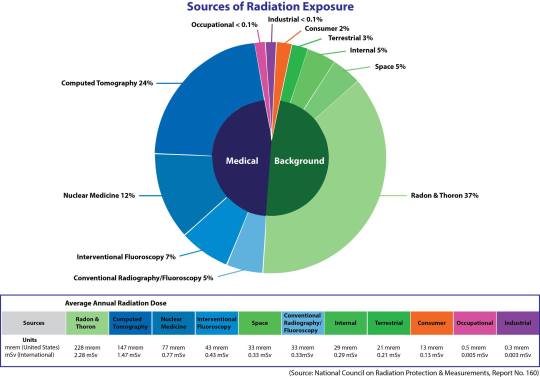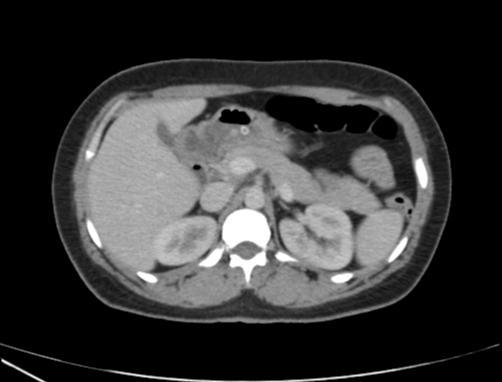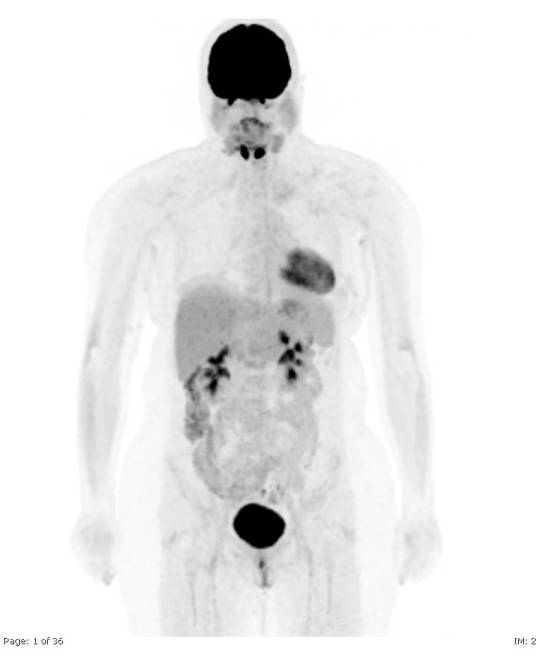#RadPhysics
Explore tagged Tumblr posts
Text

Average radiation dose to a member of the public in the USA is 6.2 milliSieverts (mSv). Approximately half of this radiation (3.11 mSv) comes from background sources in the environment or food we eat (radon, sunlight, food, terrestrial on the pie chart shown). The other half comes from medical, occupational, industrial, and consumer sources.
This week we will look at the effective dose of common radiologic studies, to aid both physicians and patients in understanding the radiation risk of these studies. However, note that in almost all cases, the benefit of making a correct diagnosis for the patient outweighs the radiation risk. An indicated study should not be withheld due to concerns over radiation risk.
Image source: EPA https://www.epa.gov/radiation/radiation-sources-and-doses
#TeachingRounds#FOAMEd#FOAMRad#Radiology#Radiation#RadiationBiology#Physics#RadiologyPhysics#RadPhysics
0 notes
Text
I am proud of myself. 😁
Radphysics - 50/100
Which is hindi ko talaga naaral. And since college is my fucking weakness. Sobrang nakangiti ako ng nalaman kong naka 50 ako. Knowing na mahirap talaga sya. Sa peer group ko, 2/8 lang kaming nakapasa.
Anatomy i got 81/100! Hurray! Highest namin is 83. Not bad right?
Sarap pala sa feeling na confident ka mag sagot. Hahaha i only answered the exam for an hour. (Patient care and management and anatomy.)
Yung 200 items na hindi pa nachecheck-an. Bukas ata. I am soo done todaaay! Hahahahaha
By the way, i treated myself with unliwings! Whooo! I ate 28 pcs. Hahahha
bye bye!
PS. 2am na ako nakauwi kanina. Tapos 5:30 ako gumising. Hahahah cool. Wag nyo na pansinin yung score. Bobo ko kaya para sakin mataas na yan. 😂😂
18 notes
·
View notes
Text
Radiation Physics.
Radphysics, gaano ka nga ba talaga kabagsik? Hindi ko kasi alam kung paano ako magsisimula. MAJOR SUBJECT YAN, take note. Pano ba naman kasi hindi pa naman nagsa-start yung lesson. Hahaha, excited. Ewan ko ba, medyo kinakabahan ako, ang dami kasing negative comments about dun na mahirap daw tapos masipag pa yung professor na na-assign samin na magbigay ng pre-tests and post-tests. Sabi din samin na combination daw yun ng Physics and Chemistry. Na-meet na namin yesterday yung professor namin sa radphysics laboratory and we also had our groupings. Epic groupmates, isa lang yung ka-vibes ko. I don't know how to handle it. Bahala na talaga. Tiyaga at sipag lang. Kakayanin, hopefully!! I wanna hear more descriptions about this subject, para naman magkaron pa ko ng maraming background about this. If meron, feel free to reply. ;)
3 notes
·
View notes
Text
Ohh Radiation Physics, why you have to be such a head ache? :/
0 notes
Text

The 2-view chest radiograph has an average radiation dose of 0.1 mSv. This is about 10 days worth of background radiation exposure.
#TeachingRounds#FOAMEd#FOAMRad#Radiology#Radiation#RadiationBiology#Physics#RadiologyPhysics#RadPhysics
0 notes
Text

Radiation exposure from CT scans varies by anatomy imaged, CT scanner settings, and size of the patient. Modern CT scanners have built-in dose reduction techniques that have reduced radiation exposure significantly relative to older scanners. Some examples of average radiation doses for CT scans (and equivalent background radiation) are below. Recall that background radiation exposure in the US is ~3.1 mSv.
CT head - 1.2 mSv (7 months background radiation) CT chest - 6.1 mSv (2 years) CT Lung cancer screening - 1.5 mSv (6 months) CT abdomen and pelvis - 7.7 mSv (2.6 years) CT full spine - 8.8 mSv (3 years)
Source: American College of Radiology https://www.acr.org/.../Radiation-Safety/Dose-Reference-Card
Image: Normal transaxial CT image showing liver, kidneys, pancrease, spleen and stomach/bowel. Case courtesy of Tariq Walizai, Radiopaedia.org, rID: 169691
#TeachingRounds#FOAMEd#FOAMRad#Radiology#Radiation#Physics#RadiologyPhysics#RadiationBiology#RadPhysics
0 notes
Text

The average effective dose from a conventional screening mammogram is 0.4 mSv (about 47 days background radiation). Digital screening mammography is 0.21 mSv (24 days background radiation), and digital screening mammography with tomosynthesis is 0.27 mSv (32 days background radiation). Learn more about breast cancer screening at the link below.
Image: Normal MLO views from a screening mammogram. Source: https://screening.iarc.fr/atlasbreastdetail.php?Index=047&e=
#TeachingRounds#FOAMEd#FOAMRad#Radiology#Radiation#RadiationBiology#Physics#RadiologyPhysics#RadPhysics#BreastImaging#Screening#ScreeningMammogram#Mammography
0 notes
Text

Radiation exposure from nuclear medicine studies is shown below. Because the radiation is injected intravenously, exposures for nuclear medicine studies is often higher than non-nuclear studies (see yesterday's post for CT comparisons).
FDG PET/CT - 8-14 mSv (2.5-4.5 years background radiation)*** MDP Bone scan - 6.3 mSv (2 years) MAG3 renogram - 2.6 mSv (0.8 years) HIDA scan - 3.1 mSv (1 year) GI bleed scan - 7.8 mCi (2.5 years) VQ Scan - 2.2 mSv (0.7 years - note that this is lower than CTA chest)
***Exposure varies by injected activity, which can be lower on modern scanners with state-of-the-art detectors
Source: Mettler et al. Radiology, 2008. https://pubs.rsna.org/doi/10.1148/radiol.2481071451
Image: Normal FDG PET scan. Case courtesy of David Little, Radiopaedia.org, rID: 77382
#TeachingRounds#FOAMEd#FOAMRad#Radiology#Radiation#RadiationBiology#Physics#RadiologyPhysics#RadPhysics
0 notes